



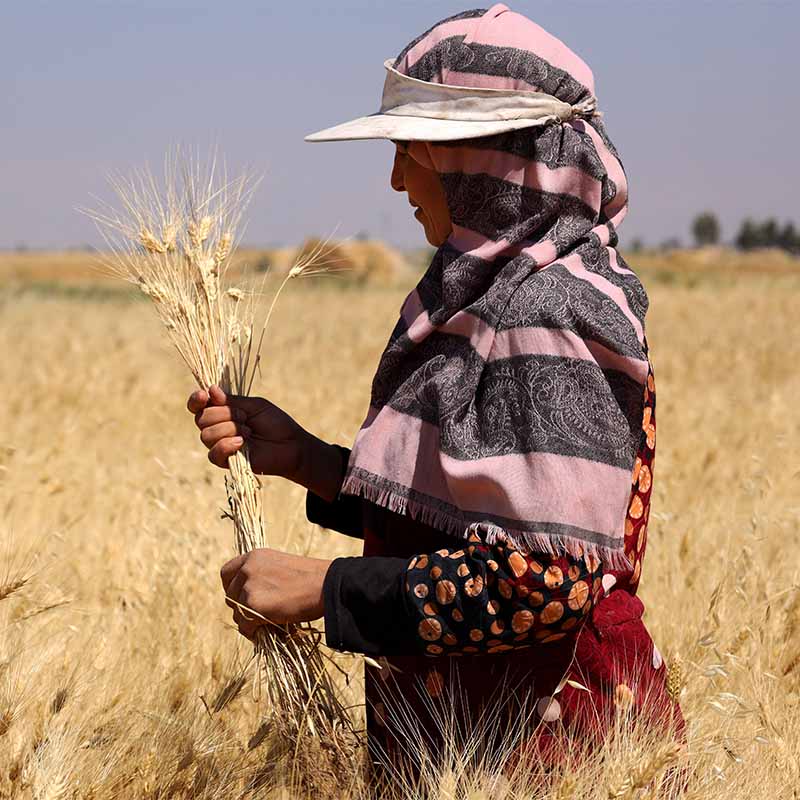


Women play important roles in agrifood systems, ranging from farmers and unpaid contributing family workers to retailers, wage labourers and entrepreneurs. This participation in agrifood systems changes over time with economic development, but their conditions of work and the associated outcomes continue to be directly influenced by gender imbalances in bargaining power in the household, the community and broader society, as highlighted in Chapter 1.
In this chapter, we look at how men and women engage in agrifood systems, in both paid and unpaid roles, the characteristics of their engagement and how these have changed since 2011 when The State of Food and Agriculture 2010–111 was published. (See Box 2.1 for our definition of employment and Annex 1 for the classification of agrifood-system activities and details about data sources.) The chapter examines the factors that contribute to differences in work patterns and economic outcomes between women and men. The chapter highlights, where possible, how age, ethnicity, socioeconomic and migration status and other social factors intersect with gender, deepening disadvantages and inequalities in outcomes, and how the unpaid work burden on women further undermines their economic empowerment.
How employment is defined – such as whether subsistence agriculture is counted as employment, or whether we consider the multiplicity of men and women’s productive activities – has significant implications for the measures of women’s and men’s employment and the composition of employment in agrifood systems.
In agrifood systems, women and men may be self-employed (with employees or without employees, in which case they are referred to as “own-account” workers), contributing family workers on family farms and family agrifood enterprises, and/or wage and salaried workers in family or commercial agrifood enterprises. Women and men may also work in enterprises at different scales and for diverse markets, both local and international, or they may produce mainly for their own consumption. All these activities constitute work in agrifood systems, but not all are considered employment, which includes only activities performed for pay or profit. The distinction between work and employment was adopted in 2013 at the nineteenth International Conference of Labour Statisticians (ICLS).i As a result, production that is mainly intended for own consumption – such as subsistence agriculture – is now classified as work but is not considered employment.
The changes to the definition of employment can create a major break in employment statistics over time. Figure A illustrates this with examples from Sierra Leone and Uganda. In both countries, significant shares of working men and women work in subsistence farming – as high as 50 percent of working women in the case of Sierra Leone. Both total employment and agrifood-system employment thus decrease significantly when subsistence farming is excluded from the employment estimates.

Given the importance of production for own consumption and food security in low- and middle-income countries, the role women play in production and the interest in understanding changes in labour-market patterns over time, we focus on a broader definition of work, which is aligned with how employment was defined prior to the nineteenth ICLS.
Globally, the share of both working men and women in agrifood systems declined by almost 10 percentage points between 2005 and 2019. In 2019, 36 percent of working women globally were employed in agrifood systems, down from 44 percent in 2005, while 38 percent of working men were employed in agrifood systems, down from 47 percent (Figure 2.1). This reduction is driven by declining employment in primary agricultural production; the share of those working in off-farm segments of agrifood systems remained the same.
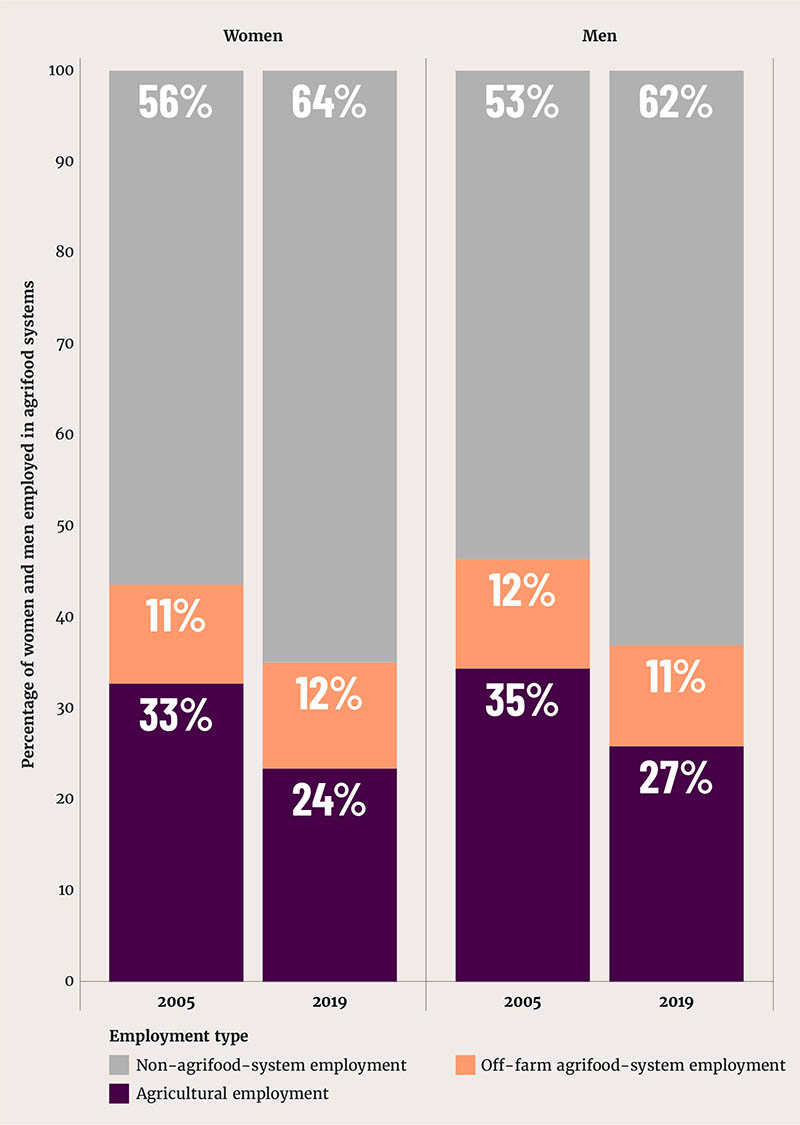
Declines of women’s employment in agrifood systems are evident in all regions apart from southern Asia, where it has remained stable (Figure A2 in Annex A). The regional trends in southern Asia are dominated by India, where female participation in the labour force is low – only about one in five women are working or looking for a job – but labour-force participation is relatively high among the poorest women, who depend on agriculture.2
Agrifood systems remain the main employer for women and men in sub-Saharan Africa and southern Asia, but they are a far more important source of livelihood for women than for men. In sub-Saharan Africa, 66 percent of women’s employment is in agrifood systems, compared with 60 percent of men’s employment (Figure A2 in Annex A). In southern Asia, 71 percent of women workers are engaged in agrifood systems, compared with 47 percent of men workers. In southern Asia, opportunities in other sectors appear to be opening faster for men than for women, as evidenced by the significant decline of the share of working men in agrifood systems in the last decade and the absence of change in the share of working women in agrifood systems.
Agrifood systems are a far more important source of livelihood for women than for men in sub-Saharan Africa and southern Asia.
While globally a larger number of men than women are employed in agrifood systems, women constitute 50 percent of all agrifood-system workers in sub-Saharan Africa and over 40 percent of all agrifood-system workers in several other regions (Figure 2.2). There is substantial variation in the share of women in agrifood-system employment across countries even within the same region. For example, women constitute 36 percent of all agrifood-system workers in Latin America and the Caribbean but 54 percent of all agrifood-system workers in the Plurinational State of Bolivia. In many countries in the region, the share of women among agrifood-system workers has grown since 2005: by 9 percentage points in El Salvador, 8 percentage points in Colombia and 6.3 percentage points in Ecuador. In southern Asia, the regional estimates are dominated by India, where the female share of agrifood-system workers decreased by one percentage point between 2005 and 2019, but the patterns in several other countries in the region are very different. In Nepal, for example, 64 percent of all workers in agrifood systems were women in 2019, an increase of 8.4 percentage points since 2005. In Bangladesh the female share of workers in agrifood systems increased from 36.2 percent to 45.3 percent between 2005 and 2019, while in Afghanistan it grew from 25.6 percent in 2005 to 33.7 percent in 2019.

Agrifood systems are often the largest employer of young people under age 25. This is particularly true in countries in sub-Saharan Africa, where about a half of the population is currently under 25 years old and the World Bank estimates that there will be half a million more 15-year-olds every year between 2015 and 2035.i Data from the sample of 11 sub-Saharan African countries in Figure A show that more than 50 percent of workers under 25 years old are employed in agrifood systems in all countries. Agrifood systems also play an important role for youth employment in the three non-sub-Saharan African countries in the sample – Georgia, Guatemala and Peru.
Agrifood systems are more important as a source of employment for women than for men of all ages in most of the countries. A U-shaped relation between agrifood-system employment and age is visible in many countries, and this relationship is especially pronounced for men’s employment in the sector in several countries. Young women (15–24 years of age) enter agrifood-system employment at a higher rate than young men in six countries and rates are similar in five countries, while young men enter at a higher rate in three countries. This is followed by a dip in agrifood systems participation between ages 25 and 35, with men in almost all cases exiting agrifood systems at greater rates than women. Gender differences in mobility may help explain the gap in agrifood-system participation: women’s greater domestic and child-care responsibilities in this age group may constrain their ability to seek opportunities away from the home and outside agrifood systems.
The share of both men and women working in agrifood systems starts to increase again after age 35 – faster among men – and the gender gap in agrifood-system participation starts to narrow until it closes by age 65 in nearly all sub-Saharan African countries in the sample.
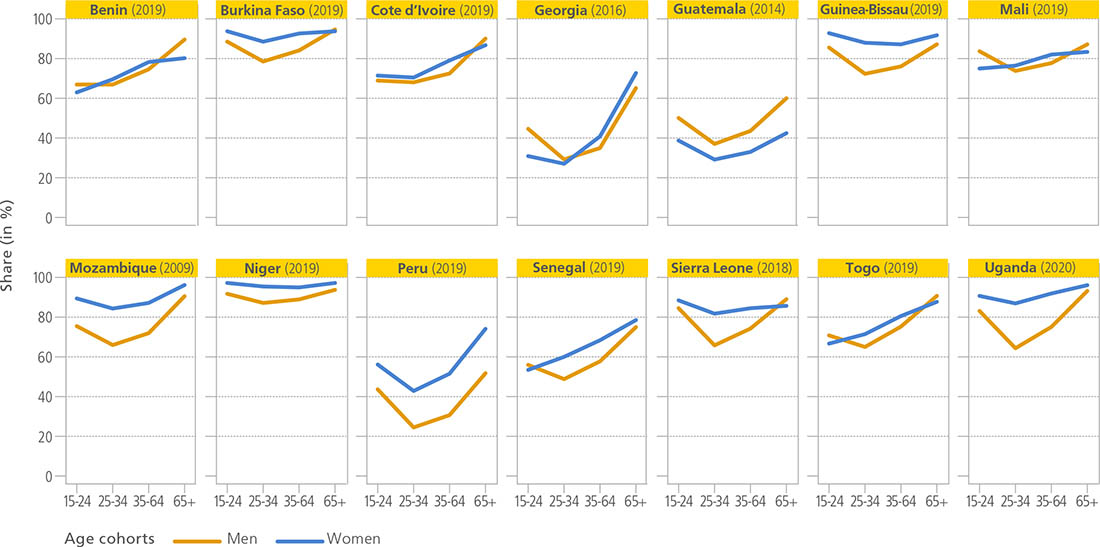
Women comprised 38 percent of all agricultural workers in crop, livestock, fisheries and forestry production around the world in 2019, a decrease of only 1 percentage point from 2000. Women do not constitute the majority of agricultural workers globally, nor is their share in agriculture increasing in most regions (Figure 2.3), pointing to little evidence of “feminization of agriculture” at the global or regional level.
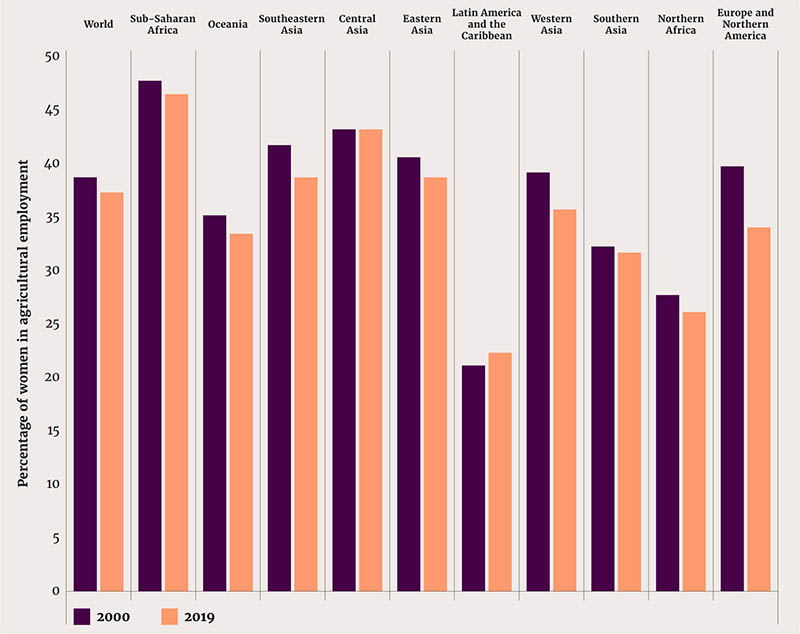
However, the regional figures mask significant differences between countries in the shares of women in agriculture and how these shares have changed over time. In general, women account for a greater share of agricultural employment at lower levels of economic development, where inadequate education, limited access to basic infrastructure and markets, high unpaid work burden and poor rural employment opportunities outside agriculture severely limit rural women’s off-farm work opportunities. In many sub-Saharan African countries women constitute well over 50 percent of the agricultural labour force. In several countries in Southeast Asia, including Cambodia, Lao People’s Democratic Republic and Viet Nam, the share of women in agriculture is high – about half of the labour force in agriculture is female – and it has remained so over the last 15 years. Agriculture is also the main employer for a larger share of female workers than male workers in Bangladesh, India, Pakistan and other countries in southern Asia, but the smaller number of women in employment or looking for work (in the labour force) in the region reduces the influence of women’s strong participation in agriculture in the global and regional estimates.3



Women’s share in the agricultural workforce is also higher or increasing relative to that of men in rural areas with significant male-dominated outmigration. This seems to be a factor contributing to high rates of participation of women in the agricultural workforce in low- and middle-income countries in southern and Central Asia and Latin America and the Caribbean. Male outmigration and the feminization of agriculture are not always associated with improvements in the well-being and empowerment of the women who remain in rural areas as there are socioeconomic and cultural factors that mediate the outcomes (see Box 2.3).
The “feminization of agriculture” – a term used to describe women’s increasing roles in agriculture over time and in relation to men – has received considerable attention in the last two decades.i, ii, iii, iv The outmigration of men from rural areas is seen as a key driver of the feminization of agriculture.v, vi In many rural societies, gender and cultural norms restrict women’s mobility, leading to a predominance of male outmigration, which can trigger profound changes in the intrahousehold division of labour and relations.
Male outmigration and the feminization of agriculture can have either positive or negative implications for the well-being and empowerment of women. Empowerment is a multidimensional process (see Chapter 4) and there may be trade-offs across the various dimensions.iv When men migrate, women often take on more work in the household, including tasks in agriculture traditionally done by men.vii, viii, ix In the absence of their husbands, women are more likely to be seen as primary farmers rather than contributing family workers.ix However, men’s outmigration often leads to increased work burdens for women who remain in rural communities. In Viet Nam, for example, women’s workload increased due to male outmigration as they had to take all the management decisions on the farm and also carry out activities traditionally done by their husbands such as irrigation, dredging field canals, applying fertilizer and pesticides and taking the output to the market.x But higher workloads are not always disempowering if they are also accompanied by higher economic well-being and fulfilment. Higher workloads may accompany greater autonomy and responsibility, as was found in Mozambique.xi
Significant gains in women’s decision-making power and autonomy have been observed following the migration of male family members in several countries, including Bangladesh,xii Guatemala,xiii Moroccoxiv and Mozambiquexi and in Southeast Asia.x Women may have greater opportunities to attend agricultural trainings, learn about new technologies and make decisions independently.xv However, other studiesviii, xvi, xvii, xviii, xix, xx do not find compelling evidence of such gains or point to detrimental effects of male outmigration on women’s health and food security. Women are more likely to take on farm labour than managerial roles, which may have more drawbacks than benefits.vi
The relationship between the feminization of agriculture and women’s empowerment is mediated by various factors. These include the characteristics of the migration experience such as its duration and direction, whether it is temporary, seasonal or permanent, domestic or international, and whether sufficient remittances are sent back home. When migrants are unable to send remittances, or send them irregularly, family members, and in particular women, can be left vulnerable to poverty and at increased risk of food insecurity.xiv, xxi In some contexts, women’s increased involvement in agriculture takes place where the economic viability of agriculture is diminishing because of climate change and other stressors (see also Chapter 5).xix
The socioeconomic characteristics of the family members who remain also matter. Age and position in the household are important determinants of the level of agency women possess and of their gains from male outmigration.xv Younger women are less likely to gain agency when men migrate, particularly when they live in extended families with other adults present.xxii In Nepal and Tajikistan, for example, the migration of a family member is associated with positive effects on the agency of both land-owning and landless women, while in Senegal the positive impacts are only among women in households with land.xxii Gains in agency can also be short-lived. When men return from migration, women may still be at a disadvantage in the process of renegotiating agricultural labour roles.xxiii
Despite greater, more nuanced understanding of the issues around the feminization of agriculture,iv more work is needed to understand what policies and programmes can support women’s economic opportunities and agency in contexts of male-dominated rural outmigration and contribute towards more equitable gender relations and outcomes and greater prosperity for their households.
Women face systematic inequalities in the types of value chains in which they engage, the conditions of their engagement and the returns they receive. While this can vary by context, women are in general less likely than men to participate in higher-profit cash- and export-commodity chains as entrepreneurs and independent farmers because they often lack the necessary access to land, water, agricultural extension and other complementary resources (see Chapter 3). Social norms also underpin the division of labour and distribution of decision-making power in agriculture. In line with their ascribed “breadwinner” role, men tend to dominate the value chains and value-chain segments where profit margins are higher. Women are overrepresented in less-lucrative value chains, such as in the production of food for home consumption and for local and informal markets, which can be seen as an extension of their domestic roles and responsibilities.4
While women often provide substantial labour inputs in value chains traditionally considered under men’s domains and are not systematically excluded from lucrative value chains,5,6 their labour contributions tend to be less visible and unpaid or poorly paid. In male-dominated chains, women might provide “hidden” labour as unpaid family labour, as shown by case studies of value chains for cocoa in Ghana,7 cocoa and coffee in Papua New Guinea8 and aquaculture.9 Preparatory work and services traditionally done by women – such as cleaning the nets and preparing the bait in fisheries, cooking meals for hired labour and mixing pesticides – are underreported, as they are not for pay or profit.
Greater profits from the increased commercialization of value chains are often associated with women having less control over the activities and income. Reports of men increasing their participation in value chains that are traditionally in the domain of women when they become profitable come from various value chains and regions including aquaculture and fisheries,10, 11 livestock,12 small-scale oil palm,13 shea14, 15 and traditional staple crops like banana.16 To maintain control over crop management and income, women may choose to cultivate crops with a lower market value.12,17 In cocoa and coffee value chains in Papua New Guinea, for example, women assisted in cash crops production, particularly during harvesting, but gave priority to producing and marketing food crops, where they had greater control over the production and income.8
Social norms may also hold back women from entering value chains and agribusinesses dominated by men. For example, a national agribusiness programme in Nigeria that gave women (and men) the chance to choose from among 11 different value chains found that 57 percent of women still selected the poultry value chain, which is traditionally dominated by women and has lower profitability than other value chains.18 Women in male-dominated activities have been shown to achieve higher profits than women entrepreneurs in female-concentrated sectors19 but experience reductions in some domains of agency and well-being.18
The off-farm segments of agrifood systems are an important source of livelihood for women in countries at all levels of economic development. As explained in Chapter 1, the off-farm segments of agrifood systems refer to economic activities beyond primary production in agriculture (crop, livestock, fisheries and forestry). In countries at lower levels of development, women tend to play a far greater role than men in these segments (Figure 2.4). Women comprise 41 percent of all workers in the off-farm segment of agrifood systems globally, but 60 percent of workers in the off-farm segment in sub-Saharan Africa (Figure 2.2). Fewer women are found in the off-farm segment of agrifood systems in countries where their mobility is particularly constrained because of discriminatory social norms that prevent them from spending time away from their home, travelling long distances and interacting with outsiders20 or in countries in West Asia and North Africa that are highly dependent on agrifood imports.21
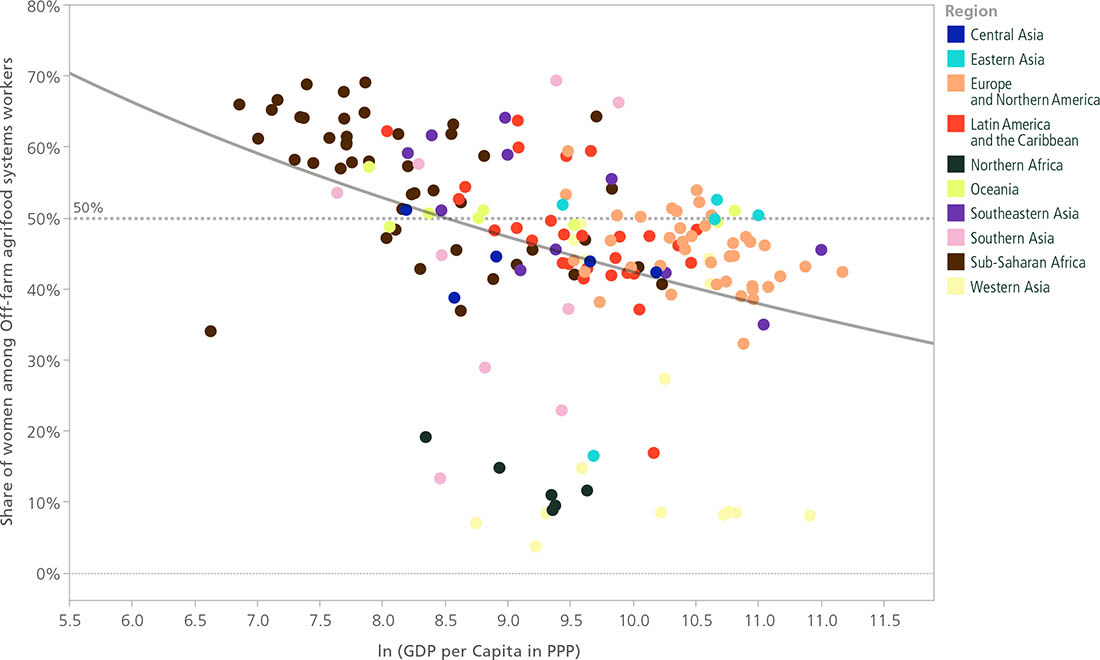
Gendered patterns of participation in and returns from off-farm agrifood-system activities vary and depend on the type of value chain, local institutions and job characteristics.22, 4 First, wherever processing activities are involved, women tend to be engaged at higher rates than men. Examples come from diverse contexts such as coffee value chains in Uganda,23 cassava value chains in the United Republic of Tanzania,24 jute value chains in Bangladesh25 and coffee, cocoa and dairy value chains in central Nicaragua.26 In West Africa the processing sector is dominated by women and tends to be unskilled and labour-intensive.27 Half of all workers in food processing and services and 40 percent of workers in manufacturing of non-food agricultural products (such as tobacco, paper and textiles) are women (Table 2.1).
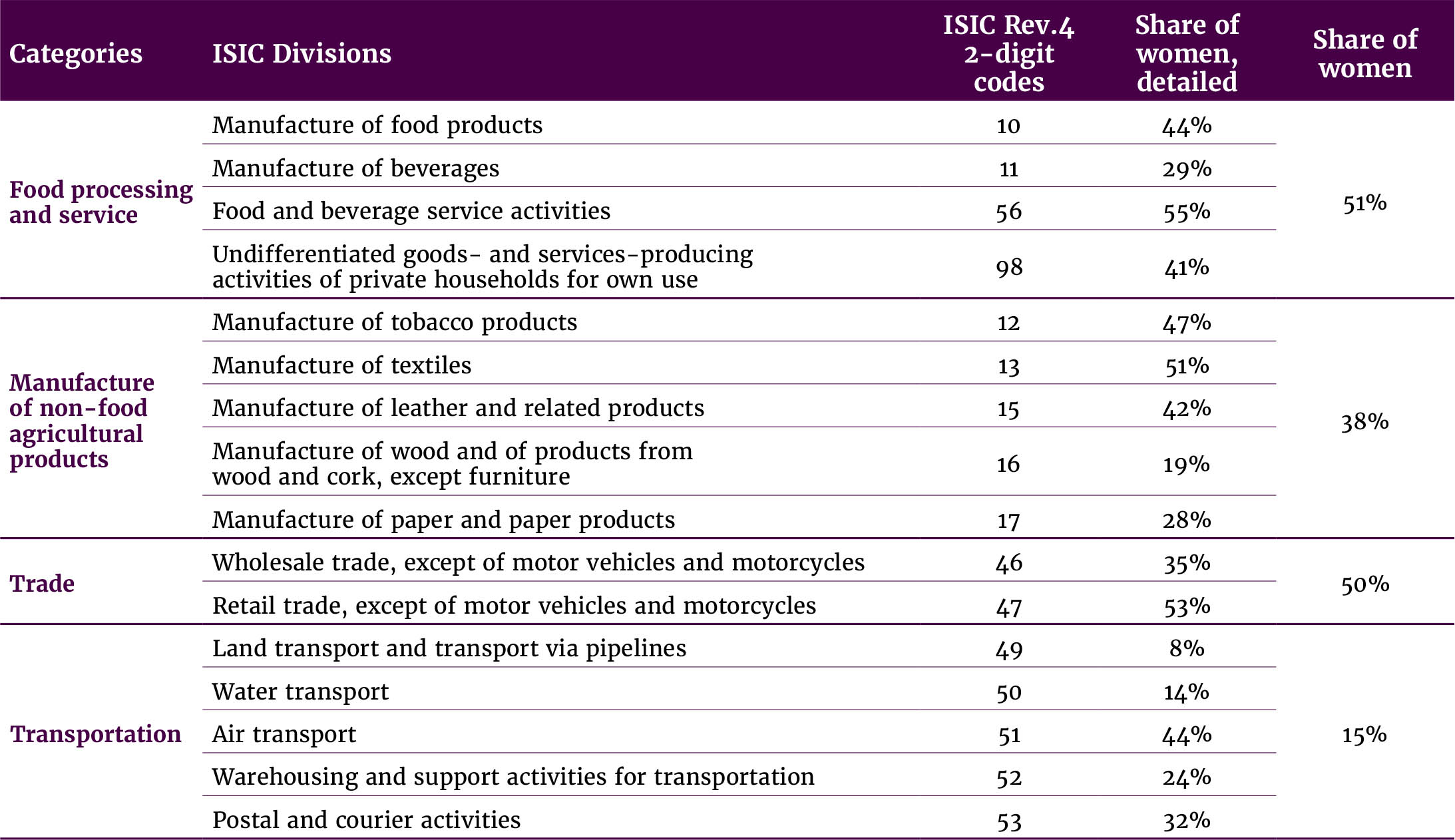
Second, across various value chains, few women are involved in the more profitable activities of transporting or wholesale trading.24, 25, 28, 29 Transport and wholesale tend be dominated by men, at least in part because they require greater capital, higher mobility and interactions with outsiders.23, 26 Women account for only 35 percent of all wholesale workers and 15 percent of transport workers in agrifood systems (Table 2.1). Even fewer women are likely engaged in wholesale and transport in low- and middle-income countries.
Third, women participate in marketing of agrifood products, particularly in domestic and informal markets, but their involvement in trading can vary widely across and within countries depending on the commodity and proximity to urban and peri-urban centres. In areas closer to larger urban centres, women are highly engaged in retailing which serves as an important source of independent self-employment (e.g. in Guatemala28 and Nicaragua26). A 2022 FAO study of food retailers conducted in six countries in sub-Saharan Africa and Latin America and the Caribbean reveals that a large share of food retailers in sub-Saharan Africa are women, while women comprise a smaller share of food retailers in Latin America and the Caribbean.30 In sub-Saharan Africa, the share of women retailers varied from 57 percent in Kenya and the United Republic of Tanzania to 75 percent in Senegal. In comparison, 26 percent of retailers in Ecuador and 31 percent of retailers in Paraguay were women.30 Globally, women are estimated to account for around 53 percent of all retail trade workers in agrifood systems (Table 2.1).
The same study also found that women trade in less-profitable commodities than men. Women are overrepresented among retailers of fruits and vegetables, in particular those rich in vitamin A, pulses, nuts and seeds, and staple crops (including grains, roots, tubers and bananas), which are among the lower-profit products, whereas men are more likely to sell industrially processed foods and beverages (Figure 2.5, Panel A). Men also account for a larger share of retailers in a range of animal products with higher returns. Women account for a larger share of fish retailers in four out of the five sub-Saharan African countries in the sample (see also Box 2.4). Female retailers also tend to sell lower volumes of food products than male retailers. As a result, female retailers report significantly lower monthly profits than do male retailers. In five out of the seven countries, men’s profits are more than twice as high as women’s profits (Figure 2.5, Panel B).
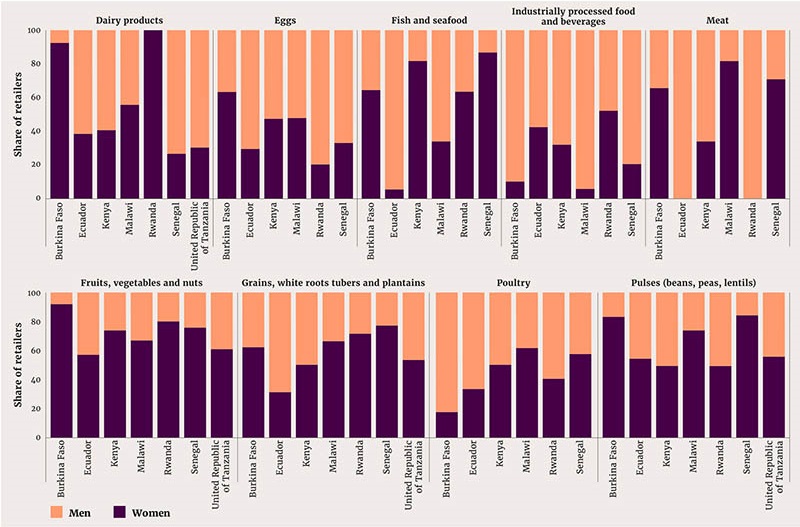

Lake Victoria is home to more than 200 species of fish and a growing number of people who depend on them for nutrition and income. FAO and World Vision have explored the effects of changes in the environment and economic trends on the livelihoods and relations of the men and women engaged in the fish value chains in the region using a gender-equality and social-inclusion approach.i
To understand the dynamics affecting stakeholders, 19 focus groups with diverse actors in the value chain for the silver cyprinid fish (known as omena in the local language) were carried out in four beach communities within Homa Bay, Kenya. Among the participants in the focus groups discussions were boat owners (20 percent of whom were women), fishers (no female fisher), traders and processors (20 percent women) and consumers (70 percent of whom were women). The study included 12 key informant interviews with chiefs of beach management units, all of whom were male, and transporters, 80 percent of whom were male.
Traditional norms and taboos assign omena fishing to able-bodied men, while processing and trading are female-dominated activities. Participating in omena supply chain activities such as capture, trade and processing requires the person to be registered with the government through the local beach management units. Registrants must be Kenyan, pay a registration fee and provide a letter of good conduct from the village chief, disadvantaging women, who are less likely to be able to meet all the requirements.
Most boat owners are men. Access to financial capital is an important factor in becoming a boat owner. Men still own the majority of assets in Kenya and can thus take a formal loan more easily than women. Although informal and communal lending groups have increased access to capital for women, the elderly and people with disabilities, this has not translated into greater ownership of boats or related assets perhaps because social norms and lack of prior experience in fishing may discourage women from investing in boats.
Traders in the area, typically women, purchase fish directly from boats. Access is therefore governed by relationships with the boat owners and male fishers. Due to their weak bargaining position, women and their dependents are exposed to serious risks and related health hazards. Women are vulnerable to sexual abuse and exploitation in exchange of commodities, such as sex for fish, a practice which also increases the spread of HIV/AIDS in fishing communities.ii, iii, iv
Lack of drying and storage facilities limit shelf life of fish and lead to losses. These issues are likely to increase in the context of a changing climate,v multifaceted crises and ineffective policies, affecting women and other vulnerable groups the most.
The livestock sector provides income to some 60 percent of rural households.31 Fisheries and aquaculture primary sectors employ nearly 60 million people worldwide and millions more across the entire aquatic food value chains.32 One-third of the global population, and more than 90 percent of people living in extreme poverty, depend on forests for food, medicine, income and more.33 Despite their importance in rural livelihoods, there is a dearth of robust global- or national-level datasets that document the gendered patterns of participation, power relations and returns in livestock, forestry and fisheries subsectors.22
Women’s roles and gender relations in livestock, forestry and fisheries often differ by the type of species and final product, market orientation, scale of operation and the sociocultural contexts in which the value chains are embedded. Traditional gender norms tend to be biased against women, 34, 35, 36 relegating them to jobs with lower returns.
Case studies point to women comprising a larger share than men of poor livestock keepers but a precise estimate is difficult to come by. 37, 38 The share of women in the livestock sector also varies significantly by livestock species. The most profitable breeds of livestock (cattle, camels and buffalo) are often under the control of men; women are more likely to control less-profitable livestock breeds (poultry and small ruminants).39, 40 Across the developing world, smallholder poultry value chains tend to be dominated by women.41
Nonetheless, women tend to be responsible for day-to-day animal care and management and processing of animal products,42 while their roles in marketing of animal products can vary substantially by product and context. For example, a recent study30 found a majority of women trading in eggs in only one country (Burkina Faso) and in poultry in two countries (Malawi and Senegal) (Figure 2.5 Panel A), reinforcing the message that men’s participation in livestock-related activities increases with greater market orientation. Women account for a larger share of dairy product retailers in three out of seven countries – Burkina Faso, Malawi and Rwanda. Women are commonly more involved in informal than formal markets,39, 43 and as a result their contributions may be underreported and data may poorly reflect their realities of working in the sector. Furthermore, as women are more likely than men to keep locally adapted livestock breeds, they are seen as preservers of livestock diversity.42
Despite the limited cross-national data on women’s participation in the livestock sector, livestock interventions remain key in agricultural development and have been linked to significant improvements for women’s well-being. Increasing women’s access to support and inputs can improve animal health and livestock productivity.44 Livestock species that are commonly under the control of women, such as poultry, rabbits, pigs and goats, require less initial capital than larger livestock, and investments in activities involving these species can have significant impacts on the incomes of women, especially those in remote areas45 and in pastoralist46 and marginalized communities (see also Box 2.5).47 When livestock interventions include extension, training and education they have a strong impact on women’s incomes and assets and on empowerment (about which more is said in Chapters 3 and 4). However, livestock interventions are also notable for their consistently more negative impacts on labour or workload, indicating that these interventions increased demand on women’s time.48
An increasing number of studies show how gender and other intersectional identities can mediate roles and power relations in agriculture, including in livestock, fisheries and forestry chains.
In forestry, intersecting identities such as age, marital status and ethnicity can influence rights to forest and tree-based food products. For example, upon divorce or spousal death, women in some Peruvian communities may lose their rights to extract Brazil nuts from community forests.i In Burkina Faso, rights to access certain tree-based food products is characterized by a hierarchy based on the woman’s lineage, marital status and migrant or resident status.ii
In the livestock sector, young rural women are often disadvantaged in dairy commercialization processes because of mobility constraints imposed by their husbands and lower access to their own transportation.iii Being of low caste, belonging to a certain ethnic group or living in remote regions are additional factors that can make women less visible and less likely to be reached by livestock development programmes.iv, v Low-caste women may also be less likely to benefit from training courses or participate effectively in livestock cooperative governance.vi However, as a study from India shows, livestock cooperatives that seek to empower women of all castes and engage with men are able to support women’s empowerment in an inclusive manner.vi
In fisheries, gender and other intersectional identities mediate inclusion, power relations and adaptive capacities. For example, in Nigeria richer women attract better patronage from fishermen than poorer women and have greater decision-making powers and influence as to where the caught fish is going to be sold.vii In Tamil Nadu, India, women involved in fishing-related work with medium to high levels of wealth and with wider social networks had greater adaptive capacity to seasonal stresses than those of lesser wealth or with weaker social networks.viii
Twenty-eight percent of all workers in the aquaculture primary sector are women, as are 18 percent of all workers in the fisheries primary sector, but the share of women increases to about 50 percent of all workers when the entire aquatic value chain (including pre- and post-harvest) is considered.32 However, their jobs tend to be more precarious than those of men: women hold only 15 percent of the full-time positions in the aquaculture and fisheries primary sectors, and 71 percent of the part-time jobs in processing are held by women.32
Populations in low- and middle-income countries are especially dependent on small-scale fisheries, which account for 50 percent of total catches32 but are frequently overlooked in studies, statistics and policies. A recent study50 found that women accounted for 39.6 percent of all people working for pay or subsistence throughout the small-scale fisheries value chain and 49.8 percent of workers in post-harvest areas.
Occupational segregation is found at different nodes of the value chains in fisheries and aquaculture, which can vary by species and sociocultural context (see Box 2.4),51, 22 but women are in general less likely to participate in the most lucrative activities. For example, men dominate offshore and high-value fisheries, while more women than men are involved in the harvesting and gleaning of shellfish and invertebrates.52, 53 Women tend to trade in medium- to low-value species and in smaller volumes and are frequently excluded from the most lucrative value chains, as studies from Egypt, the United Republic of Tanzania, Zanzibar and Zambia show.9, 54 And although women account for a large share of workers in the processing node of aquaculture and fishery value chains, they are particularly overrepresented among seasonal or part-time workers, frequently paid less than men even for the same activity and largely absent from middle- and higher-management positions.10, 55
Women comprised around 23 percent of all people employed in forest-related work in the period 2017–2019, based on a sample of 69 countries.56 The share of women in the forest workforce is lower than that of men, particularly in forestry and logging and the manufacture of wood and wood products, at least in part because of assumptions about women’s suitability to the intensive physical labour required. But the true number of women engaged in forest-product value chains may be significantly underestimated in current statistics because women are more likely than men to have informal jobs in the sector56 and in general, many activities, particularly in the processing and trade of forest products, are informal and unregulated.22
Gender specialization in activities may differ by region and product. In Africa and Asia women are mainly holders of traditional knowledge and gatherers of edible wild plants;57, 58 activities such as hunting and timber harvesting are dominated by men.59, 60 In Africa and Asia the collection of fuelwood is mainly done by women, while in Latin America the collection of fuelwood is an activity for men.59
Gender patterns of participation in forest-product collection are often related to the physical demands of the task (climbing trees, heavy lifting, etc.) and where it is carried out, with social norms, personal safety concerns61 and domestic responsibilities limiting women’s options.62 Women’s lesser access to transport restricts how far they can travel to collect forest products63, 64 and their access to more profitable markets.65
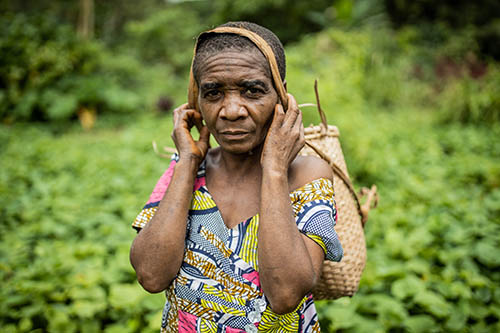


A global review of the literature on gender in forest, tree and agroforestry value chains found very little information about women’s and men’s participation in the processing and trading of forest products, particularly in Asia and Latin America.62 However, available sources of information and case studies strongly suggest that women are overrepresented in both processing and trading in forest products.62 Women dominate small-scale non-traditional forest-product trading; men are more likely to own and manage the larger businesses.62 Inadequate access to resources and services tends to restrict women to activities that require little capital and limits their ability to engage in more profitable tree-based enterprises.66, 67, 68
Sustainable Development Goal 8 calls attention to the quality of employment, highlighting the need to foster full and productive employment and decent work for all. However, the conditions of work in agrifood systems are often worse for women than for men. This section examines different dimensions of the quality of work within agrifood systems from a gendered perspective, including type of employment and whether it is vulnerable, access to full-time work, unpaid and care work and gender-based violence (see Box 2.6).
Power dynamics and norms within the household, at the workplace and in the community affect the possibility of outside employment for women. Women’s low bargaining power, lack of access to resources or safe transportation, fear for their safety and community norms around women’s freedom of movement and employment can restrict the type of work they take on or where they go to work.i, ii
Violence at work takes several forms, including economic, psychological, physical and sexual abuse and sexual harassment.iii While the extent of different forms of workplace violence in agrifood systems is unknown, case studies on sexual harassment and violence point to high prevalence of gender-based violence in the workplace.iii In Ecuador, for example, more than half of women agricultural workers in the export flower industry who were interviewed reported experiencing sexual violence and harassment by supervisors and other workers.iii, iv Women’s noncompliance with sexual requests comes with negative consequences, such as being dismissed, not being offered more work, having hours or payment cut and unfair performance appraisals.iii, iv, v, vi, vii Women street vendors may suffer from verbal, physical and sexual abuse and violence from clients and male co-workers, may be victims of robbery or driven out of their usual vending places.viii Men also face harassment and violence in agriculture.iii
Beyond the sector of work, the nature of employment can also affect vulnerability to violence. For example, temporary and informal work reinforces power differentials, which allow perpetrators to carry out violence.iii Age, migration status, socioeconomic status, lack of opportunities outside agriculture, weak social support, negative local gender stereotypes and weak labour inspection services or laws can also affect violence in the workplace.
Increasing women’s economic power can challenge traditional gender roles and responsibilities and strain gender relations. Increasing women’s employment and earnings can reduce intimate partner violence if women are better able to threaten to leave abusive relationships. However, men may also feel threatened by women’s economic empowerment and perpetrate more violence to maintain the status quo. In Bengaluru, India, and Cameroon, for instance, women’s employment was associated with increased intimate partner violence, consistent with such backlash.ii, ix, x
Most agricultural work globally continues to be carried out by own-account or contributing family workers, both of which are forms of vulnerable self-employment,69 and women are more likely than men to be in these types of employment (Figure 2.6).70 Own-account workers are self-employed workers who do not hire others, while contributing family workers are “helpers” on the family farm or in the family business and are often unpaid and have limited inputs into major agribusiness decisions. These forms of work are often informal, with no access to work-based social protection and greater exposure to economic cycles and socioeconomic and environmental risks.70
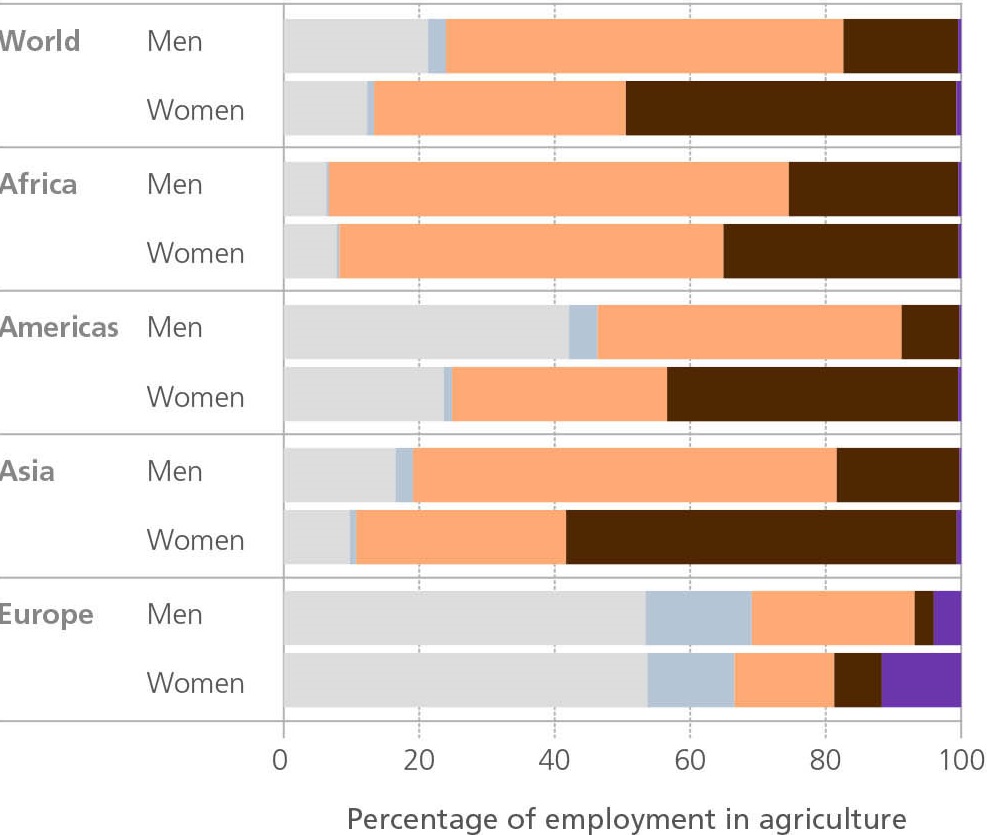
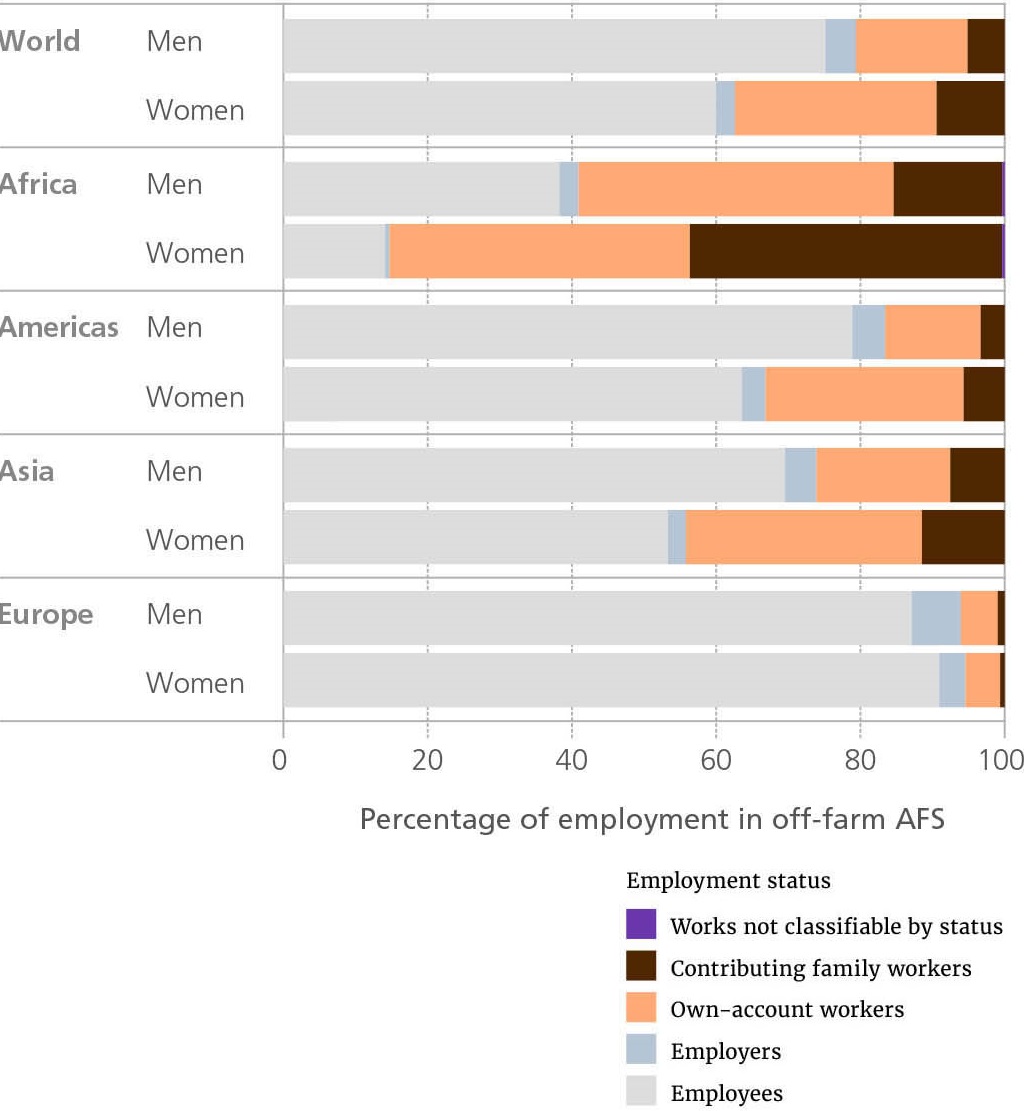
Contributing family workers are particularly disadvantaged as they do not usually receive direct remuneration and can be excluded from agricultural extension and agricultural programmes if they are not seen as farmers (as highlighted in Chapter 3). Globally, nearly half of women in agriculture (49 percent) are reported to be working as contributing family workers, compared with 17 percent of men. In sub-Saharan Africa, where women have high participation rates in agriculture, 35 percent of women engage in agriculture as contributing family workers.
Own-account and contributing family work form a smaller share of both men’s and women’s employment in off-farm segments of agrifood systems: 9 percent of women workers in the off-farm segment of agrifood systems engage as contributing family workers and 28 percent engage as own-account workers. Thus, the share of women in vulnerable self-employment (own-account and contributing family workers) improves substantially as the role of off-farm segments of agrifood systems increases.
The role of wage employment is significantly greater in the off-farm segments of agrifood systems than in agricultural segments, but in all regions except Europe, women are less likely than men to be working for wages or salaries (Figure 2.6). Wage employment accounts for the majority of off-farm agrifood-system employment for both men and women in all regions, with the exception of Africa, where the majority of off-farm agrifood-system workers are self-employed. Women in Africa are also more likely than men to be self-employed. This reflects the lack of well-paid wage employment opportunities available to women in the region.71
Yet, in various countries and regions, the growth of high-value agriculture (e.g. horticulture and cut flowers) has coincided with a rise in women’s wage employment (mainly in production and processing). Wage employment in large agribusinesses is an important source of income for many rural women, especially young women and women with small or no landholdings. These trends were already notable at the time of the 2011 edition of The State of Food and Agriculture,1 but more recent data confirm the importance of women in wage work in agribusiness and highlights the conditions under which they work. For example, 30 000 formal jobs have been created in the three main horticultural regions in Senegal; 66 percent of those jobs are held by women72 and a large share of all male and female workers are migrants from remote rural areas73 (Box 2.7).
A large share of agricultural labour in developing countries, especially in high-value, labour-intensive agrifood industries,i is often done by migrant workers.ii Workers in companies linked to global value chains tend to be women, young people and migrants.iii, iv
In the horticulture agro-industry in Kenya, most workers are women who have migrated internally from remote rural areas.v Migration can introduce challenges in women’s lives related to being away from family and support networks, but it can also be associated with positive effects such as weakening social norms and patriarchal structures that may hold women back.v Evidence from qualitative interviews speak of the important role of off-farm employment and income in strengthening women migrants’ confidence and livelihoods.v However, women continue to be paid less than men and are more likely to be temporary employees and to work without a contract.vi
Within these large agribusinesses in developing countries, women tend to be segregated into low-skilled, low-paid, informal and casual jobs,6 often under pretexts such as women’s greater patience74 and “nimble fingers”.75 Men hold the majority of managerial and full-time positions.51 Tasks that cannot be automated or are part-time are more likely to be seen as women’s tasks and are often taken up by women.76
With respect to self-employment and entrepreneurship, women own on average between 31 percent and 38 percent of formal small and medium-sized businesses, and the majority of women-owned businesses are in the agrifood sector,77 where entry capital requirements are lower than in other sectors.78, 79, 80 In West Africa, women account for 83 percent of workers in food processing and 72 percent of those in food marketing.81 In Bangladesh, women-owned businesses were primarily in the garment sector, followed by food manufacturing.77
In off-farm segments of agrifood systems, a small share of working women are entrepreneurs with other employees, and women are overrepresented among own-account entrepreneurs. Many women entrepreneurs are agrifood-system workers, including street vendors and street-food sellers. In Nigeria, it is estimated that 80–90 percent of the street-food sellers are women.77 Women often face significant barriers to formalizing and growing their businesses. For example, intrahousehold relations influence the performance and growth of women-owned businesses. A study from Ghana revealed that female entrepreneurs may prioritize savings or investment in assets and children’s education at the expense of their businesses and may also limit investment or hide income to secure the continued financial support of the husband to the household.82 Home responsibilities and care burden also affect how much time women spend on their businesses, and hence affect their growth opportunities.
Among those who work, women are less likely than men to work full time in both agriculture and total agrifood-system employment across all regions (Figure 2.7). Except in eastern Asia, women work for profit or pay in agriculture and in agrifood systems for an average of fewer than 40 hours per week, suggesting that women’s employment is part time and irregular. Both women and men spend on average more time in total agrifood-system employment. This reflects the lower influence of seasonality and thus greater availability of full-time employment opportunities in the off-farm segment of agrifood systems across most regions.
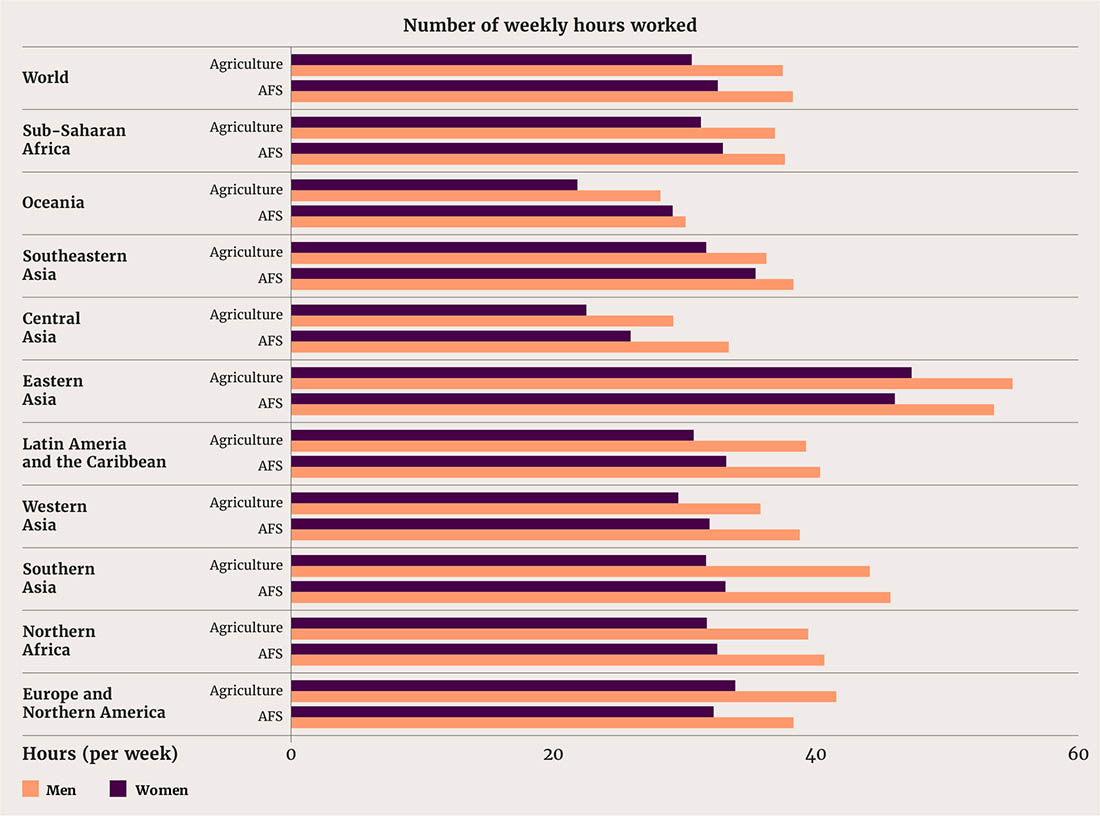
Women’s greater burden of unpaid domestic and care work contributes to inequalities in labour-market participation and outcomes.83 Women’s engagement in agrifood systems may be on inferior terms than that of men if women take on part-time, irregular, informal jobs and entrepreneurship in lower-profit segments of agrifood systems to accommodate their high unpaid domestic and care work burden.84 Time-use agency is central in this regard (Box 2.8). The burden of child care and reproductive work is associated with lower productivity of female farmers compared with that of males.85, 86 The COVID-19 pandemic brought fresh attention to how sensitive women’s participation and time in paid and unpaid work are to the impacts of crises (see Chapter 5).
In many settings, prevailing normative expectations exist concerning how women and men should allocate their time (see also Chapter 4). While men are considered household providers, traditional gender roles relegate women to unpaid domestic and caregiving activities. Time use, or how individuals allocate their time, is considered an important metric of inequity. However, growing evidence suggests that time-use agency – the individual’s confidence and ability to make strategic decisions and choose how they allocate their time – is equally salient.i
Qualitative insights from Benin, Malawi and Nigeria reveal the varied perceptions of time-use agency among women and men.i On any given day, women indicated that they were able to decide how to spend their time provided they completed expected tasks and responsibilities. However, even when women made their own decisions, it was difficult for them to act on those decisions as they required their husbands’ consent. Women risked losing their security if they deviated from such norms. Women and men were aware that men controlled decisions on tasks beyond productive and reproductive activities, such as on leisure or social time, and that men had more flexibility in deciding about and altering their own schedules. One woman explained the situation as follows: “A man can also change [his schedule] in a matter of time if the need arises. Women are always under [the] control of men, so their daily schedules are hard to change. The husband may not allow this change to happen. A man can leave the home if he wishes, but women are tied to other household chores which prevents them from doing so.”i
In addition to men’s agency over time use, both women and men in all three countries stated that men had the final say in any discussions of perceived conflict around time use.
Time-use agency is not limited to decisions by spouses. Narratives in Nepal speak to how many women who are daughters-in-law living in extended households feel dukkha or suffering, attributed to the long hours they work.ii However, one study found that there were no differences in working hours between mothers-in-law and daughters-in-law living in the same household. Mothers-in-law tended to spend more time on productive non-domestic activities, while daughters-in-law spent more time on domestic or care work. Qualitative insights revealed that the narrative around suffering is not simply about hours worked but about autonomy over time use. In this context, mothers-in-law have authority over daughters-in-law, to whom they can assign work or restrict mobility.
Global patterns in time use demonstrate the existence of substantial gender disparities in time spent on unpaid domestic and care work, such as cleaning, cooking and caring for household members and water collection, particularly in low- and middle-income countries. On average, women spend 4.2 hours a day on unpaid domestic and care work, while men spend 1.9 hours.87 Gender inequalities in unpaid care work are observed all around the world, with significant variations across countries within the same region (Figure 2.8). Gender inequalities in unpaid domestic and care work tend to be larger in rural areas than in urban areas and when time spent on care as a secondary activity is considered: across a sample of five countries and predominantly rural settings, women spent an average of 7.0 hours on care and unpaid domestic work as either a primary or a secondary activity, compared with an average of 1.4 hours for men.88 When both paid and unpaid work were considered, work burden was higher for women – 9.1 hours for women compared with 7.3 hours for men.88
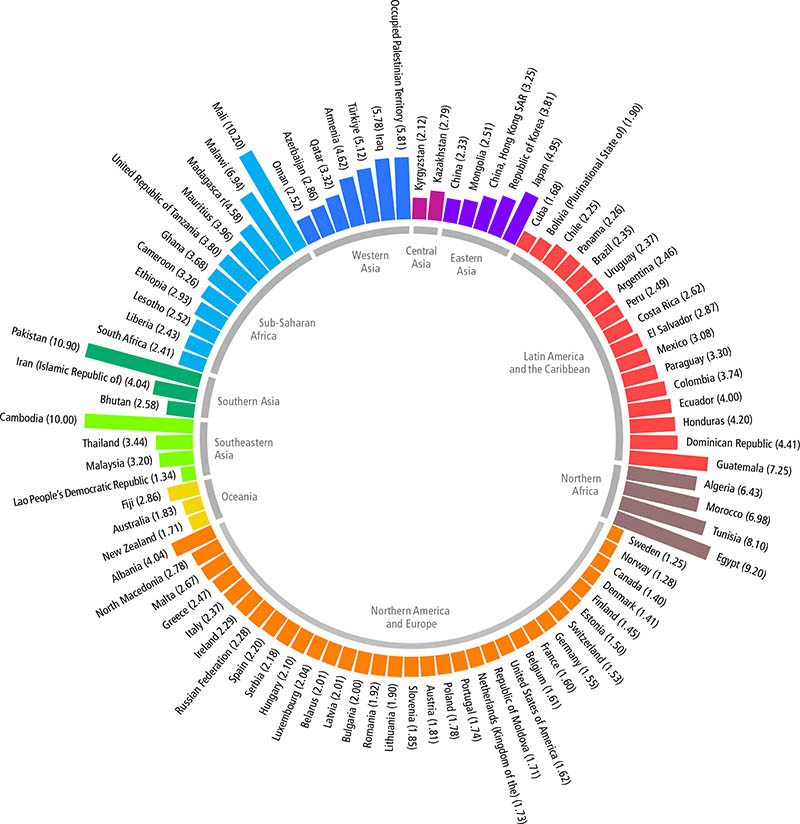
In rural areas, women’s unpaid work burden is higher than that of men in large part because of the time spent collecting water. Globally, 80 percent of the people that do not have access to improved drinking water live in rural areas.1 Due to prevailing gender norms and the gender division of labour, women and girls disproportionally bear the burden of collecting water for household and livestock needs, often travelling long distances to access water sources. 89, 2 In households that do not have a water source on their premises, women and girls are primarily responsible for water collection; 73.5 percent of households have women as primary water collector, 6.9 percent have girls, 16.6 percent have men and 2.9 percent have boys.89, 3
The time required collecting water may limit options to earn an income4, 5 and interferes with women’s other unpaid and care work.6 Girls under 5 years of age are twice as likely as boys to collect water, with negative consequences for schooling. For example, a study from South Africa showed that collecting water negatively impacted school attendance and performance, with more girls than boys reporting being late for school, being tired in class and having little time available to study.7
The unpaid care and domestic work carried out by women (and men) remains greatly undervalued despite its importance to the welfare of individuals, households and rural communities.
Even as women’s engagement in agrifood systems increases, gender inequalities in well-being and economic outcomes may persist, underpinned by continued inequalities in access to assets and resources, social norms, and policies and laws (as highlighted in the framework in Chapter 1 and detailed in Chapters 3 and 4). Gender gaps in land productivity, labour productivity and wage earnings persist, according to three recent studies prepared for this report.1, 2, 3 Using cross-country household survey data and applying an analytical approach that breaks down the drivers of inequality (see Box 2.9), the studies identify the sources of gender gaps in wages, land and labour productivity including the role of individual characteristics (age and education), household composition (using presence of young children to approximate care demands), farm characteristics (farmland size, input use and types of crops) and discrimination.
The Kitagawa-Oaxaca-Blinder decomposition approach is widely used in labour economics to study earning differentials between women and meni, ii and more recently gender gaps in agricultural land productivity.iii
This approach uses multivariate analysis to break down the average gender gap in earnings (or productivity) into the portion of the gap that is explained by differences in observed characteristics of men and women, and the portion of the gap that is not explained by differences in these characteristics. The literature often refers to the explained portion as the endowment effect and to the unexplained portion as the structural effect.
The explained (or endowment) part captures the gender differences in individual characteristics such as education, experience, occupation, working hours and the scale of the enterprise. For example, women may earn less than men but they may also have fewer years of education and experience than men or may work in smaller firms.
The unexplained (or structural) part is more difficult to interpret. It can reflect unmeasured and unobserved factors such as differences in motivation and effort (or differences in farm soil quality when the focus is on farm productivity), which are rarely or imperfectly captured in survey data. It also reflects structural differences in the returns men and women obtain for the same characteristics – such as when women receive lower pay than men for the same level of education – and thus also captures discrimination.
Gender-related gaps in land productivity remain significant. Anríquez et al.96 analyse the gender gap in agricultural productivity between male- and female-managed farms using national survey data from 11 countries in Africa, Latin America and the Caribbean and Asia. The study made three sets of comparisons: exclusively female versus male and joint farm managers in the six countries where this information is available; female- versus male-headed households in the same six countries for comparison; and female- versus male-headed households in all 11 countries (see Box 2.10 on the limitations to using male- and female-headed households). Several findings stand out.
Due primarily to data constraints, historically most studies on the gender gap in farm productivity have compared female-headed households with male-headed households instead of taking into account the gender of who was managing farm activities.
Approximating farm management with household headship has several shortcomings. Women who head their own households are often widowed, divorced or separated, or may have a husband working abroad and sending remittances back home. Women in female-headed households are not only heterogeneous, but they may face a different set of disadvantages and constraints than those living in male-headed households.ii, iii Moreover, an exclusive focus on headship ignores women in male-headed households. In many contexts, women in male-headed households oversee diverse activities within the family farm, alone or jointly either with their spouse or with other family members, but they may not be always seen as farmers.iv
Because a focus on the head of the household tells only a partial story regarding agricultural productivity, a greater effort has been made to collect sex-disaggregated agricultural production data and explore productivity gaps between farm plots managed by women and men.v, vi, vii, viii Plot-level estimates of the gender gaps in agricultural productivity from sub-Saharan African countries tend to find significant gaps in productivity, and the gaps are larger after accounting for scale or the size of the managed plot.vii, ix, x
Gender productivity gaps tend to be greater when measured at the level of the plot than when measured at the level of the farm. For example, Kilic et al.vi reported gender productivity gaps of 29 percent in favour of male plot managers in Malawi, while the gaps measured between male and female heads of households were only 7 percent. In the case of Ethiopia, Aguilar et al.v reported gender productivity gaps of 23 percent in favour of male plot managers, while the gaps were negligible in comparisons based on gender of the household head. These findings are consistent with the meta-analyses results of Anríquez et al.,xi providing further support to the current push to collect information of the gender of all farm managers. Related to this is the need for more research on joint management of family farms, which is the most common management system in many low- and middle-income countries, and how different management arrangements correlate with farm productivity and family well-being.iv, xii
First, the gender gap in land productivity in both the sample of exclusively female-managed plots (-4.4 percent) and the female-headed household sample (-1.1 percent) suggests that women farmers are more productive than men (Table 2.2). This surprising result stems from the endowment effect which strongly favours women (-17.4 percent and -9.2 percent, respectively). Why is this so? Women on average have smaller landholdings, and smaller landholdings for both men and women have higher productivity. This is consistent with the economics literature, which finds that small holdings may be managed more intensively.1 For example, farmers may apply more effort on smaller plots and plant them more frequently.

Second, different factors contribute to the gender gap in productivity (Figure 2.9). Positive effects indicate that gender differences in a particular factor are associated with greater gender gaps in productivity, while negative effects indicate that gender differences in a factor contribute to narrowing the gender gap in productivity. Across all countries and for both the gender of the household head (Panel A) or the farm manager (Panel B), the gender difference in farmland size (marked in peach) is associated with a smaller gender gap in productivity: in other words, women manage on average smaller farms than men, achieving higher output per hectare on these smaller farms relative to larger farms. Gender differences in manager traits such as education and age (in purple) and access to inputs and technologies (in red) are linked to a greater gender gap in farm productivity across the sample of countries.
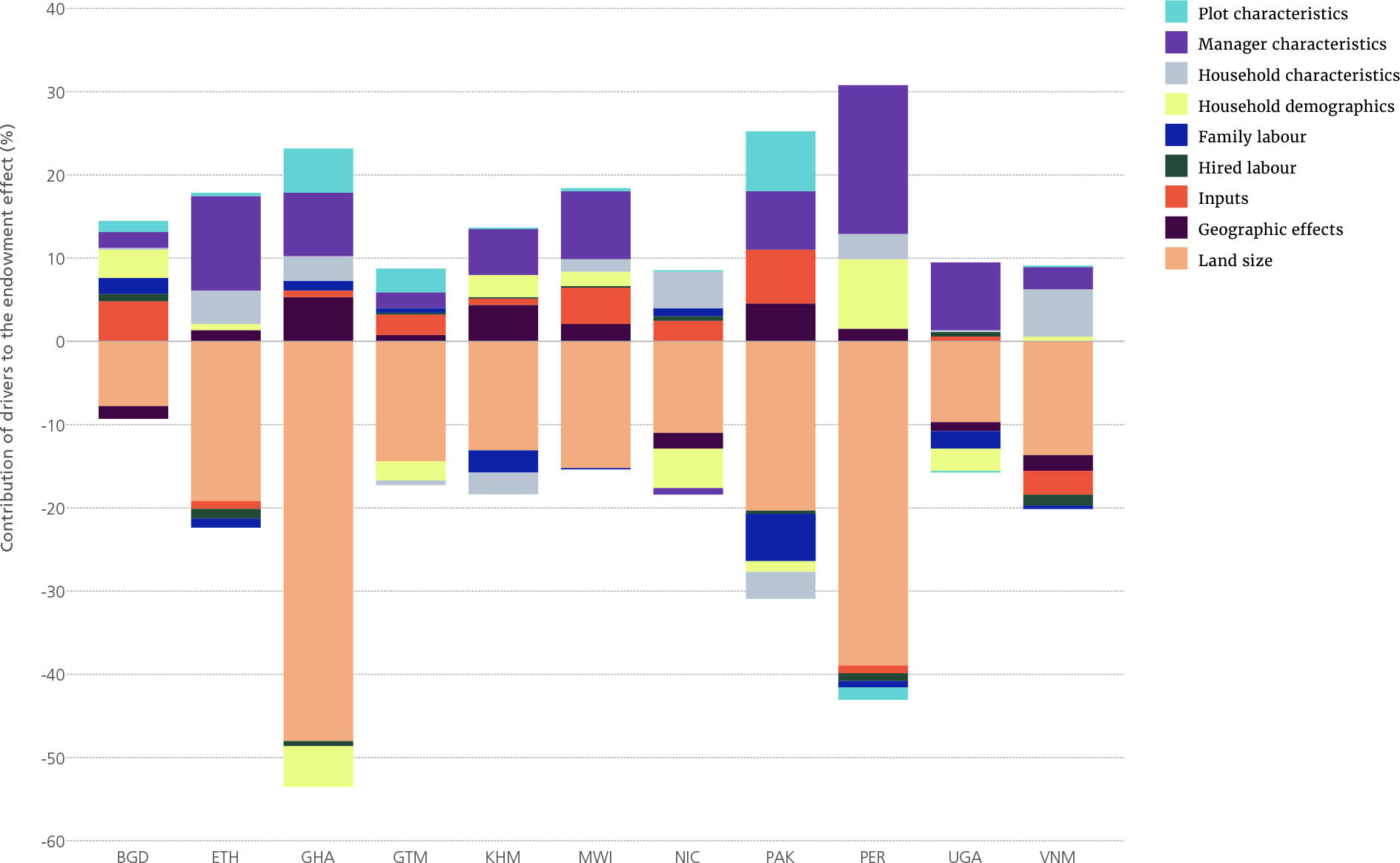
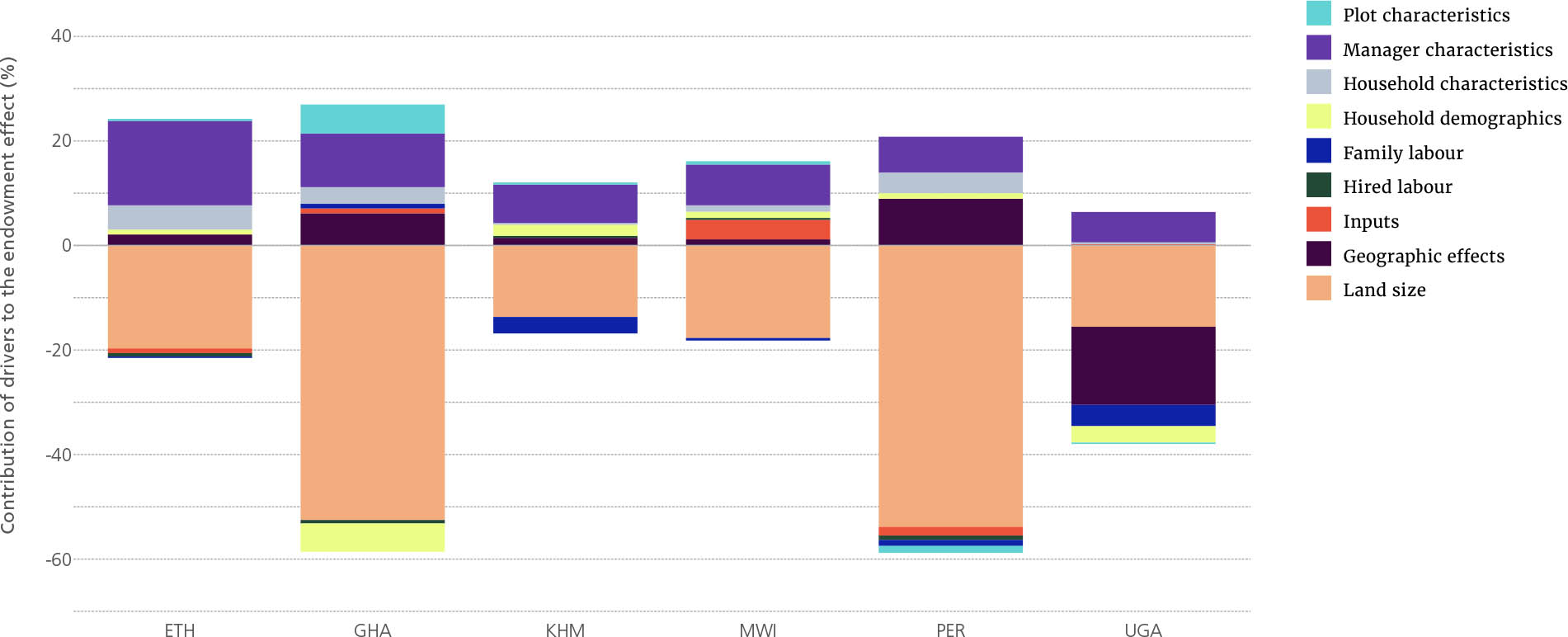
Third, the unexplained or structural effect associated with discrimination is large and always positive, contributing to a larger gender gap against women in all three comparisons (13 percent, 8.2 percent and 11.9 percent, respectively).
When farmers with landholdings of a similar size are compared, the gender gap favours men across all three comparisons by a similar magnitude (24.4 percent, 22.9 percent and 24 percent, respectively). Taken together, the gender gap favouring men over women in land productivity is approximately 24 percent.
Productivity of labour has traditionally been found to be lower in agriculture than other sectors of the economy. Recent research1, 2, 3 suggests that labour productivity in agriculture is not as low as previously thought, but that apparent low productivity is largely a problem of underemployment linked to the seasonal nature and differential intensity of crop production. As seen earlier in this chapter, women working in agriculture are less likely than men to be in full-time employment.
Relatively few studies have examined gender gaps in labour productivity. However, one study of gender gaps in labour productivity between female and male farm managers in five sub-Saharan African countries found significant gender gaps in labour productivity.97 These ranged from 47 percent in Nigeria and the United Republic of Tanzania to 2 percent in Ethiopia, with Ethiopia being the only country in the sample where there were no significant gender gaps in labour productivity among managers. The average gender gap across the five countries was 35 percent (Table 2.3). The gender gap derived mainly from the endowment effect, which captures differences in observable farmer, household and plot characteristics (28 percent). Structural inequalities, associated with discrimination, explained a smaller share of the gap (7 percent).Breaking down the components of the gender gap, the study found results similar to the case of land productivity.

Differential access to family labour, manager age and education, and responsibility for household care were associated with a greater gap in labour productivity. Conversely, the smaller land plots managed by women allow them to work more intensely and are correlated with a smaller gender gap in labour productivity.
Women are disadvantaged as wage employees in agrifood systems. Case studies suggest significant inequalities in wages between female and male employees in both agriculture and the off-farm segments of agrifood systems. For example, in the horticulture sector in Senegal women’s wages are on average 24 percent lower than those of men.72 Women’s segregation into low-wage sectors is an important contributor to the pay gap.28 But several studies show that women’s wages tend to be lower than men’s wages even for the same activities25, 1 and in activities dominated by women, such as aquaculture processing,10 pointing to pervasive gender discrimination in wage employment in agrifood systems.
Significant gender gaps were evident in wages in agricultural and off-farm activities both within and outside agrifood systems across a sample of ten countries from sub-Saharan Africa, the Near East and North Africa, Asia and Latin America (Table 2.4).98, 2 First, on average across the ten countries, women were paid 18.4 percent less than men in wage employment in agriculture. In other words, women earned 82 cents for every dollar earned by men. The gender gap in off-farm wages (within and outside agrifood systems) in these countries was smaller at 15.8 percent.

Second, in agricultural wage employment in the sample of ten countries, the structural effect – associated with discrimination – explained most of the gender wage gap (11.9 percent). These results are in line with previous findings.104, 105 Few consistent patterns were evident among the components of the endowment effect, which accounted for 6.4 percent.
Third, in off-farm wage employment, on average the structural effect played a larger role (9.7 percent) than the endowment effect (6.1 percent). While both the endowment and the structural effects were significant contributors to the gender wage gap in most countries, their respective roles varied by country. The structural effect in most countries contributed to a larger gender wage gap. The endowment effect went in both directions, expanding the wage gap in half of the countries and reducing it in three: Colombia, Egypt and Tunisia.
Among the endowment factors, the role of gender differences in education, part-time employment and employment segregation in subsectors stood out. Gender differences in education were mostly associated with smaller gender wage gaps. In the countries in this sample, the relatively small number of women participating in wage employment in off-farm activities (which include highly-skilled and professional jobs) had a similar or greater level of education than men. The returns per hour to part-time employment appeared to be higher than the returns to full-time employment, and women’s greater likelihood to work part-time was associated with smaller gender wage gaps. However, full-time employment may include additional benefits and social-security contributions, unaccounted for in the hourly wages. Gender segregation across sectors of employment was consistently associated with larger gender wage gaps in off-farm wage employment, which is in line with the literature. Women tended to be concentrated in the low-paid sectors and this contributed to a larger gap in pay.
Indigenous Peoples, and in particular Indigenous women, play important roles in conserving biodiversity, preserving common property resources and managing water resources. They are critical holders of traditional knowledgei but they continue to face significant disadvantages in agrifood systems related to poor working conditions, inadequate access to resources and deep-rooted discrimination. The majority of Indigenous Peoples (74 percent) live in rural areas and are greatly dependent on agrifood systems for their livelihoods.ii
Fifty-five percent of Indigenous Peoples’ employment is in agriculture, compared with 27 percent of non-Indigenous Peoples’ employment, and the patterns are similar for men and women.iii Trade, transportation, accommodation and food services are nearly twice as important as sources of employment for non-Indigenous Peoples than for Indigenous Peoples (31.9 percent versus 17.3 percent), for both women and men.
Poor working conditions, low pay and discrimination characterize the work of Indigenous women and men, with Indigenous women facing more pronounced disadvantages in labour markets. Informal employment is 20 percentage points higher among Indigenous Peoples than among non-Indigenous Peoples, and it is 25.6 percentage points higher among Indigenous women than among non-Indigenous women.
About three-quarters of Indigenous women’s employment is either as a contributing family worker or as an own-account worker, both of which are forms of vulnerable self-employment. Over 33 percent of Indigenous women’s work is as contributing family workers, compared with 11.9 percent for Indigenous men and 17.7 percent for non-Indigenous women in some countries.ii Wage employment plays a markedly smaller role in the employment of Indigenous women compared with all other workers. Almost 25 percent of working Indigenous women are wage and salary employees, compared with 51.1 percent of non-Indigenous women and 30.1 percent of Indigenous men. Less than 1 percent of all Indigenous women are entrepreneurs with hired labour (employers).ii
These characteristics, combined with lower levels of education, higher concentration in rural areas and entrenched discrimination, lead to an 18.5 percent gap in earnings between Indigenous Peoples and non-Indigenous Peoples. The gap is highest in Latin America and the Caribbean (31.2 percent). The pay gap is larger between Indigenous and non-Indigenous men (24.4 percent) than between Indigenous and non-Indigenous women (8.2 percent).ii
Indigenous women face unique challenges in accessing employment opportunities because of social and economic exclusion, discrimination, violations of their rights, high unpaid work burdeniv, v, vi and the lack of recognition of their traditional knowledge, practices and skills.vii With rapid rural transformation, traditional job opportunities in rural areas have decreased.v In both rural and urban labour markets, Indigenous women are found in situations of greater vulnerability than non-Indigenous women as a result of their greater participation in the informal economy, exploitation and precarious working conditions.viii Furthermore, climate change has been singled out as a major factor of rural transformation affecting the lives of Indigenous Peoples and potentially exacerbating existing inequalities.iv
Indigenous Peoples’ food and knowledge systems are multifunctional and holistic, generating food, medicines, shelter and energy, and supporting cultural, social and spiritual manifestations. This multifunctionality is rooted in understanding and engagement in agrifood systems in their totality, giving special attention to the relationships between the different elements in the ecosystem. The very existence of Indigenous Peoples’ food and knowledge systems today and their capacity to preserve 80 percent of the remaining biodiversity in the planetix constitute two of the most important contributions made to the world´s sustainability.
Indigenous women have played a fundamental role in preserving Indigenous Peoples’ livelihoods, language and culture and in managing natural resources in their territories. Indigenous women are knowledge holders, key for nature-based solutions in the context of climate action and sustainable development.
However, the systemic lack of recognition of Indigenous women’s rights, in particular their right to self-determined development and their collective rights, places them in situations of increased discrimination, vulnerability, poverty, conflict and food insecurity. Persistent lack of disaggregated data contribute to their invisibility, even within the Indigenous Peoples’ population. This fact hinders comprehensive and targeted research and thus development and implementation of policies that can address the overlapping and interdependent forms of discrimination faced by Indigenous women.x
Access to land, natural resources and territories is another essential factor for Indigenous women’s livelihoods. Governance and social structures of Indigenous Peoples have a strong impact on Indigenous women’s access to land and natural resources. The weakening or alteration of Indigenous Peoples’ governance and social structures due to changes in environmental, social and political factors negatively affects the recognition of Indigenous women’s roles within their communities and their participation in decision-making processes.x
A case study of the Wayuu people in South America has shown that changes in women’s roles has significantly reduced their economic independence as they have moved from commercial to more domestic activities and that the weakening of their matrilineal structure has resulted in a breakdown of reciprocal ties in the community and increased political segregation. This increases the vulnerability of families and reduces their resilience to climatic or social shocks.xi